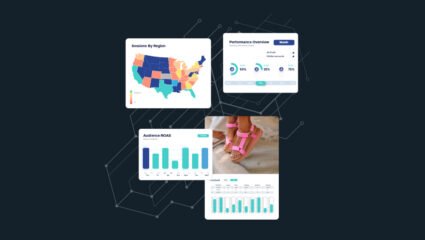Data privacy is the number one concern for online consumers, with 81% of users saying they think the potential risks of data collection by companies outweigh the benefits.
And as more privacy regulations and guidelines are put into action by governments, industries, and organizations around the world, marketers are going to have to face the inevitable: the loss of valuable marketing intelligence.
To prepare you for a first-party-data, customer-centric marketing future, we brought together some of the brightest marketing minds we know, including Editor-in-Chief of Search Engine Land Ginny Marvin, Vuori’s Director of Ecommerce Jamie Fontana, and Simon Poulton, Wpromote’s VP of Digital Intelligence.
What major data privacy disruptions should be top-of-mind for marketers?
When Google announced earlier this year that it was no longer supporting third-party data tracking in its Chrome browser, the long-foretold death of cookies got a date: 2022. Halfway through the year, Apple announced it was essentially doing the same to its Identifier for Advertisers (IDFA), a device identifier that enables advertisers to get notified when a user has taken an action like clicking on their ad or installing their app. The California Consumer Privacy Act (CCPA) also went into effect, requiring marketers to let California residents opt out of having their data sold. On top of all that, new regulations and policies are well underway—or fast approaching—making it clear that marketing leaders need to start taking action now before it’s too late.
How are marketers and their partners responding to these changes?
Marketers are going to have to think both tactically and strategically when it comes to adapting to these new data privacy challenges. Many are looking for quick-fixes to “replace the cookie,” which could be a lost cause if consumers are unwilling to consent to being tracked and targeted. More far-reaching changes include:
- Moving towards other forms of measurement and attribution
- We’ve entered into a fragmented landscape, where user-level attribution can’t be relied on to give marketers a holistic view of performance. Instead, we’ll be faced with a jumble of attribution sources. To reach accurate levels of attribution in a cookieless world, marketers will need to be able to tie identity together across addressable channels using first-party data, whilst retaining the ability to optimize and customize measurement toward the specific goals of their brand.
- Prioritizing the use of relevant, qualitative first-party data
- The death of third-party cookies represents the transfer of control from marketers to the consumer. Enter: Permission-based, first-party-data marketing. Brands will have to reimagine parts of the customer experience and find new ways to restore trust and create relevance for customers. When asking customers permission to use first-party data, keep these three best practices in mind:
- Visibility: Make it clear how and where you’re collecting data, and make it easy for customers to withdraw permission by giving them control.
- Candor: Be upfront about the reasons for collecting data and the benefits of its use.
- Value: Highlight the incentives—such as higher-quality information, more personalized offers, better communication—that come from sharing data.
- The death of third-party cookies represents the transfer of control from marketers to the consumer. Enter: Permission-based, first-party-data marketing. Brands will have to reimagine parts of the customer experience and find new ways to restore trust and create relevance for customers. When asking customers permission to use first-party data, keep these three best practices in mind:
- Defining a process for clear informed consent and radical transparency
- In March of this year, Advertiser Perceptions research found that 57% of marketers had increased transparency around data use and created new internal standards for its collection and use as a result of privacy regulations. Many went even further—limiting the information they collected, reducing the amount of consumer tracking they engaged in, and decreasing their audience retargeting efforts. Marketers and media agencies are going to have to make a choice: either continue using various workarounds to replicate the cookie, or do what consumers actually want by leading with transparency and informed consent.
“How powerful is your first party data, and how can you continue to prioritize it? While you can have as much information as you think is out there, it’s changing so rapidly that being able to digress that information, spread it to the right stakeholders, and react quickly is still going to be necessary, particularly throughout the next 12 months.”
How can you prepare your brand for privacy-first marketing?
With significant changes to user privacy, third-party cookie tracking, and the use of iOS identifiers for advertisers looming over us, it’s up to brands to take a proactive stance on data privacy. The challenge lies in finding the right balance between adhering to compliance obligations and ethical data collection policies to protect consumer choice, while also delivering personalized, relevant content that people demand. Having the ability to connect all of your data sources to get a unified view of your customer—using technologies like Customer Data Platforms (CDPs)—will be the key to unlocking the marketing of the future.
Developing a Unified Customer Data Strategy
Your customer data strategy should function as a central source for understanding how all of your data is connected. While most enterprises rely on disparate systems all over the stack, with different sources and types of data, being able to unify these systems will be a key differentiator.
- Focus on creating a consistent experience for every user so you can understand their behaviors and expectations to the fullest extent
- Take the time to build and maintain a more complete view of your customers by communicating and collaborating across functional teams
- Recognize where your data currently exists, where you want it to be six months, and what will be necessary to get it there
Less is More: The Minimum Viable Data Approach to Data Collection
Every year, it’s the same old story: Companies invest billions of dollars collecting customer data to apply to their marketing strategy and analytics. But the loss of data is going to happen, and brands must learn to embrace a “do more, with less” approach to collecting and using customer data. With minimum viable data, marketers can refine their customer data strategy with a more targeted approach.
“I really think it’s time to start thinking about minimal viable data. What is the data that’s really informing your business? What are the signals that you use that are actually amplifying what’s working, helping you make those decisions, and optimizing your campaigns?”
To adopt a leaner customer data strategy, brands need to hyper-focus on the needs of their target customers, which starts with asking the right questions:
- What data is essential to improving the Customer Lifetime Value (CLV) over time?
- When customers give you their personal data, what value are you providing in exchange?
- What sources are you using to obtain customers’ first-party data?
- How are you minimizing the amount of data you collect, while maximizing the value of limited data?
Leading with Customer Consent, Trust & Transparency
In a digital world where brands are solely focused on generating demand and increasing ROI, new data privacy regulations are often viewed as yet another hurdle for marketers to jump through. But instead of viewing privacy as a doomed proposition, what if marketers could shift the narrative and use it as a core tenant of their brand values?
“What it really comes down to is having ultimate transparency, and making it part of your brand values. The brands that lean into this early are the ones that will succeed long-term. And that is such a key component.”
If you can show that you’re responsible with data and prove that you’re using it to improve customer experience (and not just your bottom line), people will be more likely to give you their consent and have higher trust in your brand. It’s now time for marketers to shift the focus from short-term solutions and workarounds to building lasting trust and long-term brand value by advocating privacy and complete transparency as core principles of a customer-centric digital experience.







Responses